
Part I: Saving the Sea Turtles
Summer in Portland, Oregon is wonderful. Warm sunny days blend gradually into crisp nights, and even at the height of summer, it's the perfect climate to explore the Columbia Gorge, Mt. Hood and the Oregon Coast. So Why am I giving up two weeks of my hometown's best weather to visit the hot, rainy, buggy coastal areas of El Salvador and Nicaragua?
When you get the opportunity to tag along with some of the world’s leading turtle conservationists to put satellite tags on possibly the planet’s most endangered sea turtles, the only response is “Yes!” and to start looking at airfares. For ten days, I will travel with a small, diverse group of people to visit four key sea turtle habitats in two countries. We will put transmitters on turtles at three of the sites, attend turtle festivals and meet local residents working to support conservation programs.
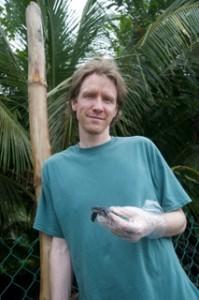
Despite having worked in sea turtle conservation for most of the past decade, this new trip will be a series of firsts for me. First time working with transmitters, first time to both of these countries, and the next wild hawksbill I see will only be the second of my career. I will be sharing these experiences with blog posts, images and more in the hopes of educating Voices for Biodiversity’s readers about the threats sea turtles face in this region and how the public can participate in their conservation.
A few of the inspiring people I’ll be meeting up with include Alex and Ingrid Gaos, the driving force behind the Eastern Pacific Hawksbill Initiative, one of the most hopeful turtle conservation stories out there; Jose Urteaga of Flora and Fauna International, a National Geographic Emerging Explorer and one of Nicaragua’s leaders in turtle conservation; and Dr. Jeff Seminoff, director of Marine Turtle Research at the National Marine Fisheries Service of the National Oceanic and Atmospheric Administration. Others include Randall Arauz, recent winner of the prestigious Goldman Prize and founder of Pretoma, a leading wildlife organization in Costa Rica; Enriqueta Ramirez, founder of VivAzul and one of El Salvador’s leading young turtle conservationists; and Liza Gonzalez, current Nicaragua Director for Paso Pacifico and former director of the Nicaragua protected area system.

Part II: Turtles in Toluca
“Possessing, selling, and consuming sea turtles is illegal in El Salvador,” says Enriqueta Ramirez in Spanish. “We are not interested in buying turtle eggs from you; we want to collaborate with you to protect sea turtles.” With these strong statements, Enriqueta is confronting a challenging history: As a young female conservationist, she is trying to change the paradigm of a male-dominated culture of turtle egg exploitation.
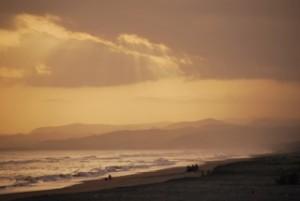
ViVAZUL is among the most effective turtle-focused organizations in the country. With funding from Fabien Cousteau’s organization Plant A Fish, VivAzul has helped to save more than 400,000 hatchlings in its two years of existence. I have come to visit this olive ridley nesting beach in the small coastal village of Toluca on El Salvador’s central coast with Enriqueta to learn how turtle conservation is working in this small, Central American country.
Toluca is not a town you’ll find on the map. Few tourists come to see the turtles or relax on its sandy beach. The approximately 40 families here live in small compounds stretched out along the coast, walls of bamboo marking the property of each family. The town’s kids know how to enjoy the benefits of oceanfront living, swimming playfully in the surf as pastel sunsets plays out over the coastal hills to the northwest.
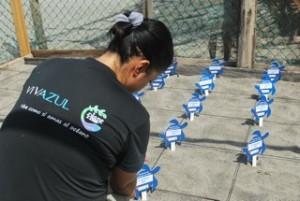
As an emergency measure, the new law has been successful. Over the past two years, roughly 80 percent of the turtle eggs in the country have been protected (about 1.5 millions eggs per year). However, Enriqueta and other turtle experts believe the egg purchasing program will not be sustainable over the long-term. Much of the money for the program has come from USAID funding, which will run out in two years. To get started on what to do after 2014, a group of leading organizations is working together to craft plans to replace the funds from other sources and invest in environmental education.
After Enriqueta finished explaining how a new system of identification would work during this nesting season, she methodically took the picture of all of the participants with her new iPhone. Quickly, the tortugueros settled into groups, playing cards and smoking cigarettes. Enriqueta and I took advantage of the down time to interview a number of the men.
The prevailing wisdom of turtle conservationists in the country is that collecting turtle eggs is a primarily economic activity; as long as the money can be replaced, the eggs will be protected. Enriqueta, however, believes that there are social factors at work. When asked to describe what its like to meet up every night to go “turtling.” the guys used words like “pastime” and “sport.”
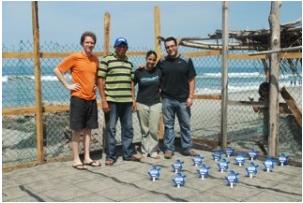
Without programs like this one, nearly every turtle egg in El Salvador would be consumed. The country has roughly 4,000 tortugueros spread out along every major nesting beach in the country. For most of these people, the money earned from selling the eggs (either to a hatchery or the black market) is supplemental but can be a significant portion of their income. One nest of 140 eggs brings in $25, more than 10 percent of the average monthly income in this area.
With people still getting used to the ban on consuming eggs, the large number of people earning income from turtling, and one of Latin America’s highest levels of poverty, saving sea turtles in El Salvador is a complicated task. Fortunately for these turtles, Enriqueta has learned to skillfully negotiate among government officials, international funders and the local group of tortugueros. Under her strong presence, most of the hatchlings of Toluca will make their way to safely back into the water.
Part III: Bay of Turtles: Bahîa de Jiquilisco, El Salvador
To arrive in a new place in the dark is like tasting a new food with a blindfold on. You can feel the edges, but you can’t begin to appreciate the colors around you until daylight arrives. Nighttime in the small town of La Pirraya – an island community in Jiquilisco Bay, El Salvador – is quiet; the fishermen and their families gather in small compounds preparing the day’s catch and saving energy for an early rise the next day. But hiding outside the lights of the town is the beginning of a conservation movement that could save one of the world’s most endangered populations of ocean wildlife.
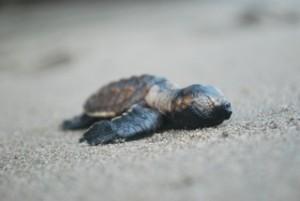
The few dozen hatchlings in the blue bucket at the hatchery were the first newborn hawksbill turtles I’d ever seen. Using a red flashlight to protect their eyes, we inspected this healthy group, each of them eager to get to the water. No sooner had we released them on the beach than we received a call about a nesting female hawksbill on a nearby island. We hopped back into the boat for another short ride across the calm water.
Hawksbills are well known for their preference for nesting much further up the beach than other species, normally venturing into the beachside vegetation to lay their eggs. That knowledge, however, didn’t prepare me for the location of this turtle, probably more than 50 feet inland on the other side of a barbed wire fence tall enough to keep people out but let turtles through underneath. That turtle perfectly illustrated why this population remained hidden for so long; many turtle experts had considered the hawksbills of the Eastern Pacific functionally extinct until just a few years ago.
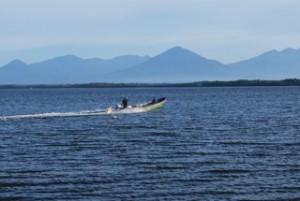
I wish I could accurately describe my first impressions of Jiquilisco Bay in the daylight, but after the long night, I was so disoriented that my vision was pretty blurred. Stumbling out of the hammock, I walked over to a 4-foot deep hole where three large hawksbills were calmly waiting to be released. These turtles were much larger (their shells measured about 3 feet long) than the one small hawksbill I had worked with years before in Costa Rica; if I didn’t know better I would have thought they were a different species. In addition, there were more hatchlings to release.
Our visit to Jiquilisco was organized by ICAPO (The Eastern Pacific Hawksbill Initiative), and these turtles are part of an ongoing study looking to unlock the mysterious life cycles of these animals. There are estimated to be fewer than 500 nesting females left in their range, which goes from southern Baja California, Mexico to Peru. Until recently, researchers assumed that hawksbills only lived in and around coral reefs, of which there are relatively few along the Pacific coast of the Americas. However, research by ICAPO and their partners has shown that these turtles live primarily in mangroves, a fact that surprised many herpetologists.
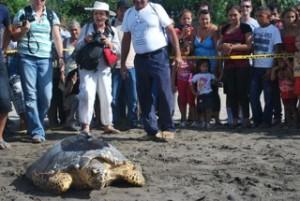
Once I finished photographing these turtles, I headed out to the beach, and the incredible beauty of this area hit me full force. Across the water, a series of perfectly shaped volcanoes rose up over the bay. As the baby turtles slid into the water, the human residents of Jiquilisco were just getting started. Fishing boats crossed the water, heading to preferred spots in the brightening day.
As we arrived back to La Pirraya, the town was in full swing, preparing for their annual hawksbill festival, complete with a parade, dignitaries, throngs of media, and more. The parade got off to a loud start with the Navy’s marching band and a procession of more than 100 local students. The students held homemade signs about protecting turtles and keeping trash out of the ocean, and a few wore turtle costumes despite the quickly rising temperature.
Many of the students stood outside a canopy, looking over the shoulders of the researchers to catch a glimpse of the turtles being prepared for the transmitters. It took more than an hour to clean and sand down the shells, place several layers of epoxy around the transmitter, and allow them to dry. Once completed, the turtles were taken to the water and released. The crowds were kept back to give the turtles room, and once they had their bearings, they went directly to the cool water.
While I was pleasantly surprised at the large turnout, the sheer number of media outlets in attendance was shocking. Roughly 30 people from seemingly every outlet in the country were there, including TV news, radio stations, newspapers, magazines, and others. The mix of cutting-edge technology, international turtle experts, and beautiful children was a potent combination that media outlets could not ignore.
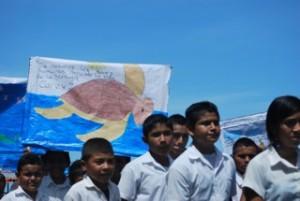
That news was a reminder that, despite tremendous progress studying and protecting Jiquilisco’s turtles over the past few years, there is still a lot of work to do. We must ensure that the bay receives protection; there are currently no regulations in place for this spectacular wildlife hotspot. ICAPO is working to guarantee protection, through government action, of the critical hawksbill habitat, namely the 50 meter fridges along the primary nesting beaches, as well as all the waters within the estuary, the minimum protections necessary to give hawksbills the best shot at survival in the eastern Pacific.
Get Involved:
SEE Turtles is supporting this work by raising funds to help pay for the egg collection. Last year, we donated more than $5,000 and hope to exceed that this year. To help support this effort, visit our website; for every $1 donated, we can save two hawksbill hatchlings at this project.
Read more about ICAPO’s efforts to protect Jiquilisco Bay and how to volunteer with the program here.
Come visit Jiquilisco Bay in November with EcoViva.
Part IV: The Last Refuge
A wide beach on a warm clear evening may be the most relaxing setting on Earth. We weren’t likely to come across any nesting turtles on this beautiful evening in the far northwest corner of Nicaragua (the tides weren’t right), but we didn’t mind. The soft sound of surf provided a soundtrack for the brightest Milky Way I’ve seen in years. Just being out on the sand was enough entertainment. But we didn’t travel 10 hours by bus from El Salvador for a tranquil beach walk.
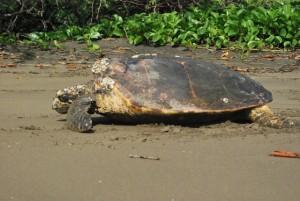
The coastal road leading into the town of Padre Ramos felt like many other spots along Central America’s Pacific coast. Small cabinas line the beach, giving surfers a place to spend a few hours out of the water each night. Tourism has barely touched the main town, however, and the stares of the local kids hinted that gringos are not yet a common sight walking around town.
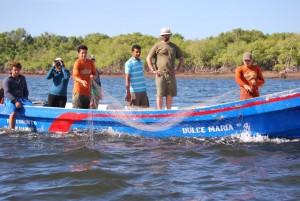
The next day, fully rested, we set off early to try to catch a male hawksbill in the water. Most of the turtles studied in this region have been females easily caught on the beach after nesting. We spotted a hawksbill alongside an island called Isla Tigra, directly in front of the Venecia Peninsula, and the team sprung into action, one person hopping out of the boat with the tail end of the net while the boat swung around in a large semicircle, the net spreading out behind the boat. Once the boat reached the shoreline, everyone hopped out to help pull in the two ends of the net, unfortunately empty.
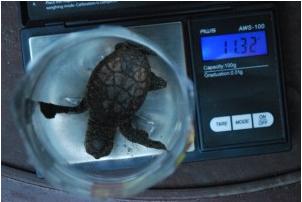
A few dozen people gathered around as our team worked to clean the turtle’s shell of algae and barnacles. Next, we sanded the shell to provide a rough surface on which to glue the transmitter. After that, we covered a large area of the carapace with layers of epoxy to ensure a tight fit. Once we attached the transmitter, a piece of protective PVC tubing was placed around the antenna to protect it from roots and other debris that might knock the antenna loose. The final step was to paint a layer of anti-fouling paint to prevent algae growth.
Next, we headed back to Venecia to put two more transmitters on turtles near the project hatchery, where hawksbill eggs are brought from around the estuary to be protected until they hatch and then are released. The tireless efforts of several local careyeros (the Spanish term for people who work with the hawksbill, known ascarey) was rewarded with the opportunity to work with cutting edge technology on this important scientific study. Their pride in their work was obvious in their smiles as they watched the two turtles make their way to the water once the transmitters were attached.
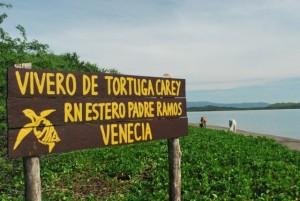
It was only a couple of years ago that these same men sold these eggs illegally, pocketing a few dollars per nest to give men unconfident in their libido an extra boost. Now, most of these eggs are protected; last season, more than 90 percent of the eggs were protected, and more than 10,000 hatchlings made it safely to the water through the work of FFI, ICAPO and their partners. These turtles still face several threats in the Padre Ramos Estuary and throughout their range. Locally, one of their biggest threats is from the rapid expansion of shrimp farms into the mangroves.
One of the tools that FFI and ICAPO hope to use to protect these turtles is to bring volunteers and ecotourists to this beautiful spot. A new volunteer program offers budding biologists the opportunity to spend a week to a few months working with the local team to manage the hatchery, collect data on the turtles and help to educate the community about why it’s important to protect these turtles. For tourists, there is no shortage of ways to fill both days and nights, from surfing, swimming, participating in walks on the nesting beach, hiking and kayaking.
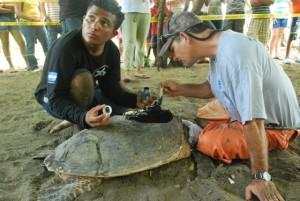
From above, the estuary, which is protected as a natural reserve, looked remarkably intact. The one obvious blemish was a large rectangular shrimp farm that stood out from the smooth curves of the natural waterways. Most of the world’s shrimp is now produced this way, grown in developing countries with few regulations to protect the mangrove forests that many creatures depend upon. While crossing the wide channel on the to return trip to town, a small turtle head popped up out of the water to take a breath about 30 feet in front of me. I like to think it was saying “Hasta luego,” until I’m able to return again to this magical out of the way corner of Nicaragua.
Get Involved:
Fauna & Flora Nicaragua website
Volunteer with this project! – Come participate with this project, helping local researchers manage the hatcheries, tag turtles, and release hatchlings. The cost is $45/day which includes food and lodging in local cabinas.
SEE Turtles supports this work through donations, helping to recruit volunteers, and educating people about the threats these turtles face. Make a donation here. Every dollar donated saves 2 hawksbill hatchlings!
Photos coursey of Brad Nahill